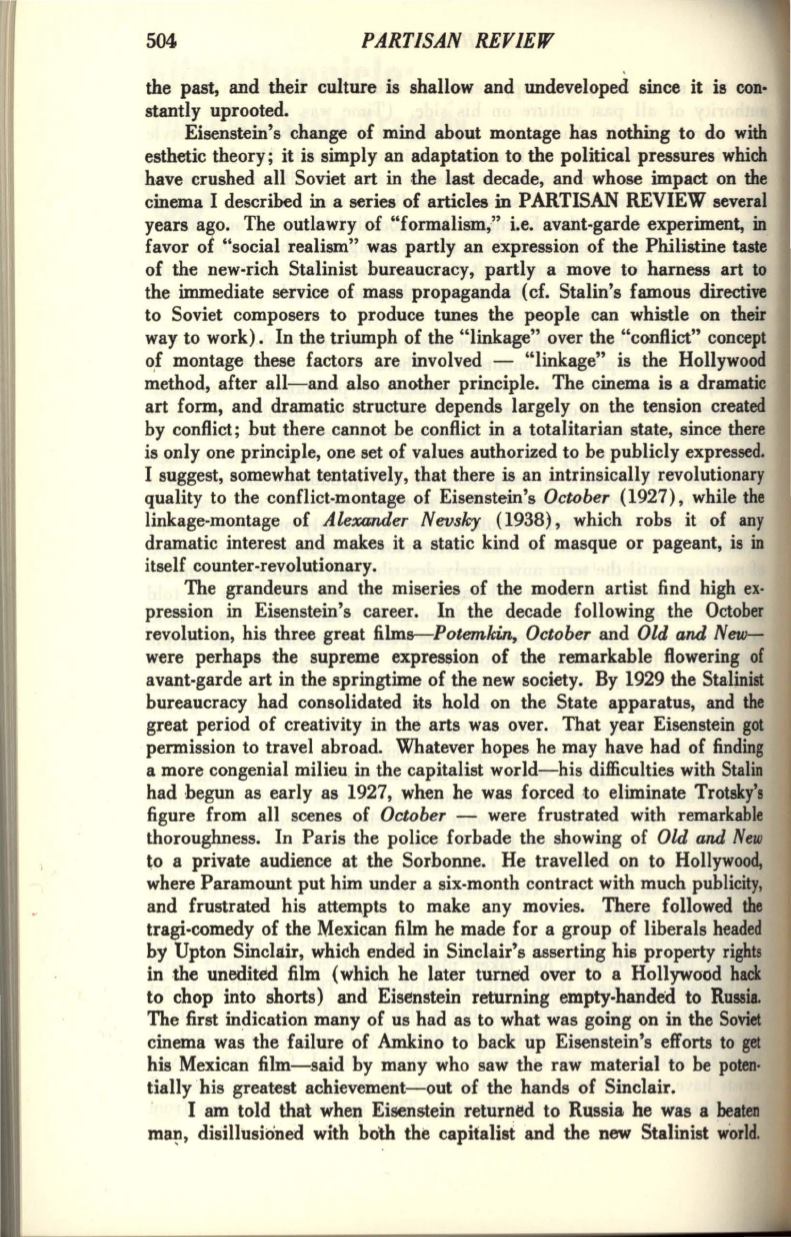
504
PARTISAN REVIEW
the past, and their culture is shallow and undeveloped since it is con·
stantly uprooted.
Eisenstein's change of mind about montage has nothing to do with
esthetic theory; it is simply an adaptation to the political pressures which
have crushed all Soviet art in the last decade, and whose impact on the
cinema I described in a series of articles in PARTISAN REVIEW several
years ago. The outlawry of "formalism/' i.e. avant-garde experiment, in
favor o£ "social realism" was partly an expression of the Philistine taste
of the new-rich Stalinist bureaucracy, partly a move to harness art to
the immediate service of mass propaganda
(cf.
Stalin's famous directive
to Soviet composers to produce tunes the people can whistle on their
way to work). In the triumph of the "linkage" over the "conflict" concept
o,f montage these factors are involved - "linkage" is the Hollywood
method, after all-and also another principle. The cinema is a dramatic
art form, and dramatic structure depends largely on the tension created
by conflict; but there cannot he conflict in a totalitarian state, since there
is only one principle, one set of values authorized to be publicly expressed.
I suggest, somewhat tentatively, that there
is
an intrinsically revolutionary
quality to the conflict-montage of Eisenstein's
October
(1927), while the
linkage-montage of
Alexander Nevsky
(1938), which robs it of any
dramatic interest and makes it a static kind of masque or pageant, is in
itself counter-revolutionary.
The grandeurs and the miseries of the modern artist find high ex·
pression in Eisenstein's career. In the decade following the October
revolution, his three great
films--Potemkin, October
and
Old and New–
were perhaps the supreme expression of the remarkable flowering of
avant-garde art in the springtime of the new society. By 1929 the Stalinist
bureaucracy had consolidated its hold on the State apparatus, and
the
great period of creativity in the arts was over. That year Eisenstein got
permission to travel abroad. Whatever hopes he may have had of finding
a more congenial milieu.in the capitalist world-his difficulties with Stalin
had ·begun as early as 1927, when he was forced to eliminate Trotsky's
figure from all scenes of
October
-
were frustrated with remarkable
thoroughness. In Paris the police forbade the showing of
Old
and
New
to a private audience at the Sorbonne. He travelled on to Hollywood,
where Paramount put him under a six-month contract with much publicity,
and frustrated his attempts to make any movies. There followed
the
tragi-comedy of the Mexican film he made for a group of liberals headed
by Upton Sinclair, which ended in Sinclair's asserting his property rights
in the unedited film (which he later turned over to a Hollywood hack
to chop into shorts) and Eisenstein retUrning empty-handed to
Russia.
The first indication many of us had as to what was going on in the Soviet
cinema was the failure of Amkino to back up Eisenstein's efforts to
get
his Mexican film-said by many who saw the raw material to be poten·
tially his greatest achievement-out of the hands of Sinclair.
I am told that when Eisenstein
return~d
to Russia he was a beaten
m~,
disillusioned with both the capitalist and the new Stalinist
~orld.


